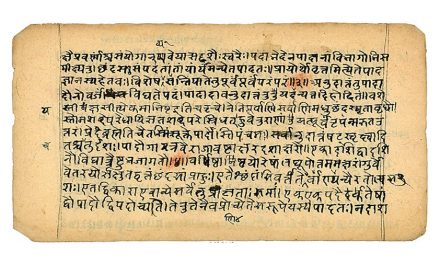The Indian yogic system has reached its culmination in the unique culture of Lord Jagannath and this in its turn is rooted in what may be called ‘Purusottama consciousness’, otherwise known as Sri Jagannath consciousness. The Sri Jagannath cult comprehends everything divine and transcends all barriers of caste, creed, colour, religion and race just as the oceanic tradition of Indian yogic culture does. Although the devotees belong to different religious disciplines and follow their typical ecclesiastical practices, Sri Jagannath cult promises them all a shadow of religious cover under all-embracing nomenclatures of Purusottama, Parambrahmaand Paramatma.
In the temple of Puri, Lord Jagannath is worshipped as Lord Vishnu, the remover of sins and giver of mukti or salvation. So the Lord is worshipped as Yogiraj and He is seated on ratnasinhasana in samadhi stage, like Buddha. Lord Jagannath symbolises Paramatma (The Supreme) and His devotees are symbolised as Jivatma (self). So the union of Lord Jagannath and His devotees is the ideal state of highest realization. In Yogasatra, the definition of yoga is mentioned as: “Jivatmaparmatmanoh Sanjogah yoga ityuchyate.”
In the Patanjali Yosasutram, yogi Maharshi Patanjali has defined “Yogaschittabruttinirodhah” as meaning yoga is the process which keeps the mind quiet, thoughtless and silent. Yoga teaches us how to keep the instruments of the soul, that is physique and the vitals, to be strong, healthy and affective. The natural body can be kept by natural processes, which are the fundamental base of Indian yoga. This is the age old realized truth of our Indian yogic culture.
Sri Jagannath culture also contains every aspects of this yogic ethics in its fold. So an aspiration of Sri Jagannath culture can get every benefit of the greatest yogic culture of Indian soil. In the temple of the Lord, Tulasi Prasada if taken on an empty stomach, can cure tonsil, cold and asthma, etc. and also works as a strong preventive for different diseases. Arati of the Lord helps for proper digestion of devotees. The bathing water of Garuda, the vehicle (vahana) of Lord Vishnu, symbolised by a pillar in the Jagamohan, works as a medicinal dose for the fever. Chandana (sandal) in the temple cures small pox, measles etc. These are the natural treatments granted to the devotees of the Lord.
Meditation in yoga gives mental peace, mental wisdom, mental concentration when a devotee sits on Nishatala, a place in front of the temple of Sri Sakhigopal in the Srimandira premises, where open air of the environment touches the body of the devotees. When a devotee compares between the Satvik customs and amorous postures (Mithunamurti) carved and fitted on the body of the temple, at that time his mind completely achieves Satvik thoughts and is filled with divine realisation. These erotic sculptures also symbolize the world of virtues and vices. It is necessary to know what is the Apara world of Maya and Satvik, Rajasika and Tamasika beings and the trigunatita of Supreme consciousness. This is also a yogic method, which is an ideal and scientific method to understand the illusion of the world and to know the highest world of cosmic consciousness. It is called the life of devotion or Bhakti Yoga.
Sri Jagannath cult teaches us to be free from all attachments and greed for food. The Lord being served 56 pauties of bhogas, He does not keep Himself attached to any such material objects of enjoyment. He is Bhabagrahi, not Bastugrahi, as He is tight-lipped and closed mouth. This is the example of complete dedication and a part of Yogic activities. The big and opened round eyes of the Lord speaks to the world that he grants Abhaya to save the world and the devotees through perfect Laya Yoga, thus the Lord teaches us to remain in such a conscious state throughout day and night.
Sri Jagannath is the pranava Omkar Purusha. Pranava is a set of five elements: Dandakam, Kunadali, Tarakam, Ardhamatra and Vindu. These five elements are imagined as Sri Jagannath, Sri Balabhadra, Mother Subhadra, Sri Sudarsana and Ratnasinhasana respectively. Omkar signifies a set of three main elements such as A, U and M. These three elements represent the names of the Trimurti, Brahma, Vishnu and Maheswara. So it is mentioned in Sanskrit Shastras: “Akare liyate Brahma Ukare liyate Harih Makare liyate Rudra Pranava tu Prakashyate”.
‘A’ means lower region (Brahma or Subhadra), ‘U’ means higher region or heaven (Vishnu or Sri Jagannath), and ‘M’ means middle region or earth (Shiva or Balabhadra). Subhadra is a power Paramatma or Sri Jagannath, who unite Jiva on earth or middle region with Param (Sri Jagannath). So Subhadra is called Yogamaya.
In Yogic tradition, from the lower region Subhadra awakes Kundalini in sleeping position on muladhara Chakra on the earth and on the head of Balabhadra towards the state of heaven (Sahasrara) or Sri Jagannath, there is the state of salvation. So Sriksetra, or Land of the Lord, is sacred and is the land of Paritrana or emancipation.
Infinite energy is at the disposal of man if he knows how to get it and this is a part of the science of Yoga. The sacred land, where there are faculties to unite self with the Supreme and devotee with the Lord, and where there are images of Sri Jagannath, Balabhadra and Subhadra to pour influence of their own ideology on the millions of their devotees, that land is called as Srikshetra or Yogapitha. So Sri Jagannath is the Supreme and His land is super and sacred, a paradise of beauty, a heaven of peace and tranquility.












